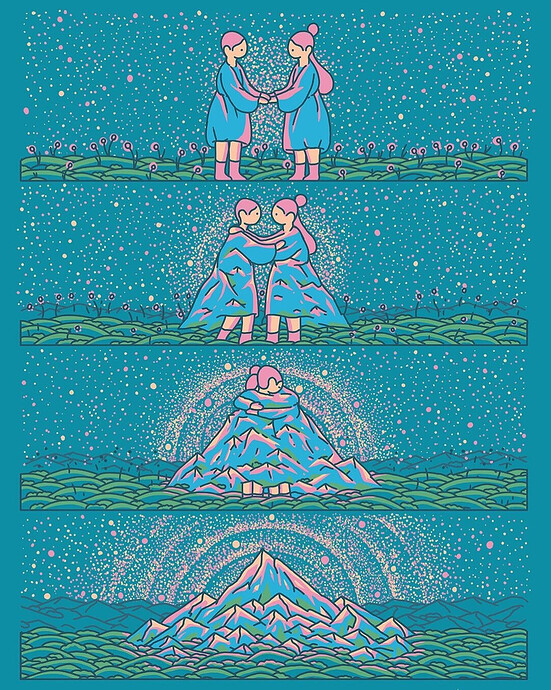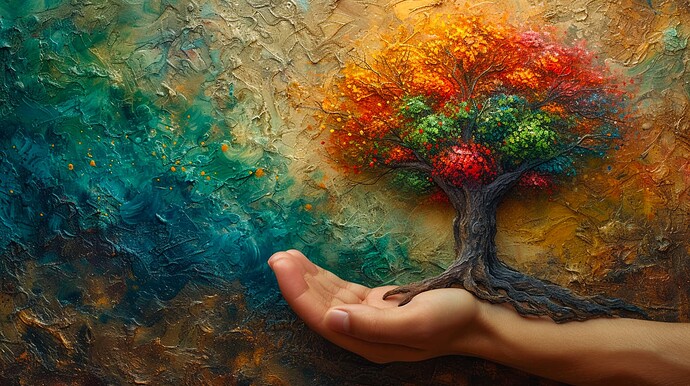Co-Creating
Co-Creating is when we consciously interweave our skills and contributions with others for mutual benefit and shared expression.
- Co-creating means we’re not carrying the sole responsibility.
- Instead of a single leader getting most of the credit and acclaim, the outcome is honored as the result of shared intentions and efforts.
- Co-creating reflects the natural ecosystem, where symbiotic relationships lead to better health and lower stress.
- We-spaces become more sustainable, enjoyable, and thriving when co-creating is conscious and intentional.
From Hierarchy to Ecosystem
Whether it is the CEO or “star of the show,” the model of creativity has often been to highlight and give the award and acclaim to the person “at the top.” Sure, the other contributors might be acknowledged, but the “feel” is everyone else supports the leader (the one who matters “most”).
Co-Creating brings forth a different mindset. Yes, there are roles and responsibilities. The co-creative intentions are set and agreed upon as participants bring their real skills, energy, insight, heartistry, and engagement to the endeavor — together.
Biologically rich ecosystems have this. Water, sun, nutrients, bacteria, fungi, insects, plants, animals, and more all contribute and all benefit.
From this perspective, families and businesses also have many different co-creative resources they tap into to survive and thrive. Indeed, co-creating is actually what is happening everywhere! We believe making it conscious and intentional brings more inclusion and empowerment to every being involved.
Co-Creating at Its Finest
For someone to teach, there must be students. The doctor needs patients. The author needs readers. The farmer needs hungry folks.
We are absolutely in this together. Even the most fiercely “independent” people are delusional if they think they are doing it “on their own.” Our interdependence is not a weakness; it’s a gift.
Co-Creating at its finest recognizes each person’s contributions. Our essential human needs include a need to contribute to others, support and be supported, love and be loved… to accept and be accepted.
For our thriving, we can pierce the notion that having needs is “a sign of weakness” and meeting needs is a “burden.” Our gifts and gaps are meant to interweave, activate us, and bring forth possibilities from growth and delight that we can pursue together.
Notice the Cooperative Components
When something matters to you… when your heartistry wants to come forth… watch for cooperative components.
A component is a part of the whole. For thriving we will always be co-creating. Other people, resources, and support will be a part of our ecosystem.
We might want a bit of reassurance… and someone nods their support. We might need a bit more money to take the next small step, and the money arrives (sometimes in surprising ways). Perhaps we need support in an area we’re not skilled in — and a person, book, or video comes our way.
It’s true that our primitive brain is typically attuned to threats. However, it can be re-tuned to look for juicy, sweet resources that arrive to nourish and support us in our endeavors. Be curious!
“I wonder where the next cooperative component will come from… and when…”
Useful Questions
- Who is co-creating with me?
- What needs are we meeting for each other?
- How might this we-space be restructured to be more inclusive and empowering for everyone touched by it?
- How might I be resisting conscious co-creating? Do I feel I’d lose power? Authority? Status?
- What cooperative components have already arrived to support me?
- In what ways am I asking for support right now?
Resources
- Co-Creating at Its Best - Book
- 3 Pitfalls to Avoid When Savvy Co-Creating - Real Skills Workshop
- Heartfelt Consent: Unlocking Joyful Co-Creation - Real Skills Workshop
Related Concepts
We-Space, Interdependence, Right Distance Right Depth, Better Boundaries, Consent
Links
- Discuss Co-Creating in the Community Center
- Share this link to the Concept of Co-Creating: https://www.thrivingnow.com/concept/co-creating

